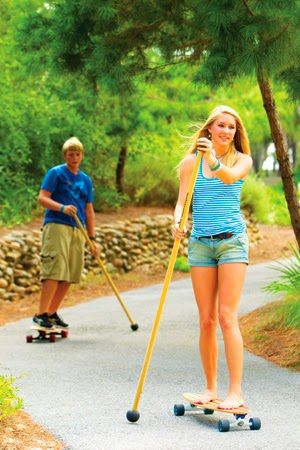By using our website, you agree to the use of cookies as described in our Cookie Policy
Land Paddling - A Cheaper Alternative To Paddleboarding ( SUP )

Stand up paddleboarding has exploded in its popularity withing the last 5 years. SUPs have been spotted around the globe, anywhere where there is easy access to safe waters, as well as in the surfing lineups of the world. A 2013 report called it the outdoor sporting activity with the most first-time participants of any in the United States that year.
Not many people had heard of stand-up paddleboarding until 10 years ago, when surfing star Laird Hamilton started catching gigantic waves standing on an oversized surfboard that he propelled with a long outrigger kayak paddle. But SUP, as it's known, didn't become today's hottest aquatic sport until average folks started doing it out of the surf zone.
SUP's sudden popularity is no surprise: it takes no great skills, its relatively low-key ( even your grandmother can do it ), safer than surfing, it offers a great workout, and it can be done anywhere there is a body of water.
But despite of its popularity, stand up paddleboading still remains a very niche sport for a very tight group of like-minded people.
The disadvantages of stand up paddleboarding are usually associated with, first of all, a relevantly high price of essential gear. High quality boards range from $800 to $2000. And paddle average between $100 ( for cheaper aluminum paddles ) to $300 for high tech carbon fiber ones.
Other major cons of paddleboarding include storing and transporting your board. With most boards averaging 10' feet and longer, it takes a lot of space to keep them in a garage or an apartment. Also, the weight of a board ( about 30-50 lbs ) makes it hard and time consuming to load/unload the board on your car's roof rack.
Stand up paddleboarding tends to be more popular in warmer climates like Hawaii, California, Florida, but in places like Pacific Northwest, where "summer time" is about 2.5 months long, paddleboarding is a seasonal sport.
Land paddling on the other hand can be done anywhere anytime in any weather !
Considered to be a popular spin-off of stand up paddleboarding, land paddle boarding, or land stand up paddle boarding is as easy as SUP, more affordable, and provides the same fun and exciting land paddling workout !
The paddling action almost exactly simulates Stand Up Paddle Boarding, only your able to do it on land. The combination of the longboard skateboards and land paddles give you an increased feeling of stability making it accessible to a wide range of people, young and old !
Land Paddling offers a great upper body workout and intense core training combined with the thrill of riding a longboard. On the flats and gentle uphills, the force necessary to propel the board comes from your shoulders, chest, back and abs. Over time, your upper body and your core plus your legs, feet and ankles gain strength and something called proprioception (your body awareness) improves. These changes in your muscles and your mind, carry over to everyday balance and confidence of footing. This is a huge benefit.
Also, one of the main advantages is that it is so accessible. You can keep a land paddle and board in your car boot so wherever you are you can have a paddle, whether it’s for a couple of minutes, a full on workout or just a relaxed cruise to chill out after a hard day. Pretty much everyone has access to an area of tarmac or concrete.
As for the coast, a popular cool longboard ( like Sector 9, Arbor, or Bombora ) will cost between $150-200, and an adjustable Kahuna Big Stick from the inventor of land paddling Kahuna Creations is $78.99
Over the last couple of years, the community of land paddlers has grown, and you'll see more people on local bike trails paddling their longboards, cruising the boardwalks, or bombing down local hills.
If you've ever daydreamed about stand up paddle surfing to work, the store, around campus, or on the boardwalk, pick up a board and a paddle, and enjoy a smooth ride while getting a great workout!
‹ Back






